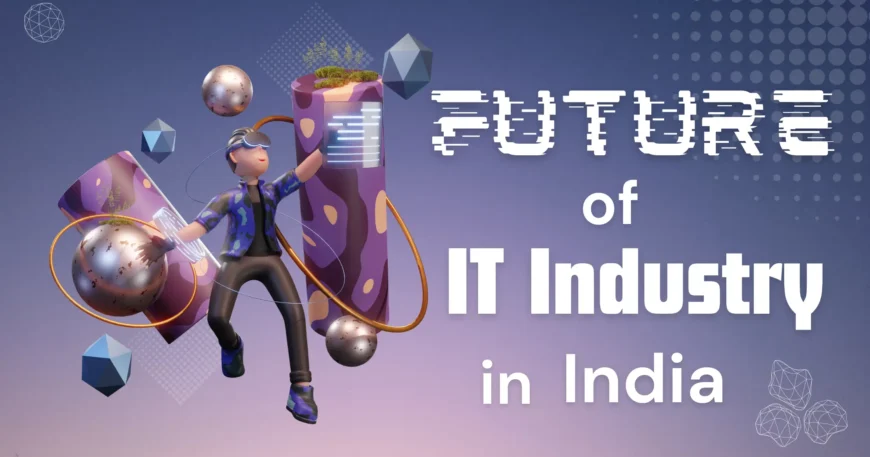Introduction
The IT industry in India is one of the fastest growing industries and has been making waves in terms of further growth. It has been predicted that the Indian IT industry will grow at an annual rate of 12% per annum over the next few years. This will mean that more and more people can join this industry as it is a rapidly expanding one which hasn’t seen any major obstacles yet.
What is the future of the IT industry in India?
The IT industry in India is one of the fastest growing economies in the world. It contributes over USD 150 billion to India’s GDP and employs over four million people. The IT sector has been experiencing exponential growth since its inception in 1981.
The demand for skilled workers has increased exponentially, which has led to higher salaries, better working conditions and more job opportunities for fresh graduates as well as experienced professionals alike.
The IT industry in India is one of the fastest growing economies in the world. It contributes over USD 150 billion to India’s GDP and employs over four million people. The IT sector has been experiencing exponential growth since its inception in 1981.
How the IT sector has emerged as a pillar of modern India
The IT sector has emerged as a pillar of modern India. The country has a large pool of talent and is home to some of the world’s most dynamic companies, including Infosys, TCS, Wipro and Cognizant. In fact, India accounts for 40 percent of global IT services exports with its contribution to GDP growing from $5 billion in 2000-01 to $150 billion in 2016-17.
The IT industry is also one of the largest employers in India; there are more than 3 million people working directly or indirectly on this front with over 1 million being added every year (Source: Nasscom).
Indian IT companies are at the forefront of digital transformation, leveraging new technologies like cloud computing, artificial intelligence (AI) and machine learning to change the way businesses operate. They have also made significant investments in innovation centers that focus on developing solutions for clients around the world.
The importance of IT to India Economy
The IT industry is the largest employer in India, with an estimated 1.8 million employees. It contributes 10% to the GDP of India and is considered one of the most important sectors of our economy.
The industry is also growing at a rapid pace, with an annual growth rate ranging between 8% and 10%.
The Indian IT industry is expected to continue its rapid growth for the next few years. The industry is also expected to face some challenges in the future, such as an increase in competition from other countries and a shortage of skilled workers.
The Indian IT industry is the largest employer in India, with an estimated 1.8 million employees. It contributes 10% to the GDP of India and is considered one of the most important sectors of our economy. The industry is also growing at a rapid pace, with an annual growth rate ranging between 8% and 10%. The Indian IT industry is expected to continue its rapid growth for the next few years.
Where is India in this everlasting IT race?
India is a rising star in the global IT industry. The country has emerged as a key player in the global IT market, and it’s one of the fastest growing economies in the world.
India is also home to some of the most innovative companies in this space–and that’s not surprising when you consider how much money they’ve invested into research and development over time. According to some estimates, India spends more on R&D than any other country except China or Japan (depending on who you ask). And that investment shows: India has been able to produce some truly cutting-edge innovations over time!
The country has also become a major hub for IT companies. A number of large firms have set up their operations in India, which has helped to boost the local economy and create jobs for thousands of people. India is also home to some of the world’s most innovative companies in this space.
What are the prospects for the IT budget in India 2023?
The IT industry is growing at an exponential rate, and it’s expected that the IT budget will be increased by 20% in the next 5 years. This will result in an increase in job opportunities, as well as an exponential growth of this sector.
The IT industry is growing at an exponential rate, and it’s expected that the IT budget will be increased by 20% in the next 5 years. This will result in an increase in job opportunities, as well as an exponential growth of this sector. The IT industry is growing at an exponential rate, and it’s expected that the IT budget will be increased by 20% in the next 5 years. This will result in an increase in job opportunities, as well as an exponential growth of this sector
How the IT industry is boosting Indias growth What can we expect in the next 20 years?
The IT industry has been a major contributor to India’s growth, helping shape its economy and contributing to its development. The future of this sector looks very bright, with many experts predicting that it will continue to grow in strength over the next 20 years.
The IT industry in India has come a long way from its humble beginnings and is now one of the largest in the world. The sector contributes 7.5% of India’s GDP and employs over 3 million people.
The IT industry in India has come a long way from its humble beginnings and is now one of the largest in the world. The sector contributes 7.5% of India’s GDP and employs over 3 million people. The future of this sector looks very bright, with many experts predicting that it will continue to grow in strength over the next 20 years.
The following are some breakthroughs in information technology that are expected to have a significant impact during the next 20 years:
1. Artificial Intelligence & Robotics
Artificial intelligence and robotics are two of the most exciting developments in IT that are expected to have a significant impact during the next 20 years.
Artificial Intelligence (AI) is the ability of a machine to perform tasks that usually require human intelligence, such as visual perception, speech recognition and decision-making. AI has been around for decades and started off as a science fiction concept in movies like Star Wars. However, it is now becoming a reality and is widely used today in areas such as self-driving cars, facial recognition software, smart assistants like Siri and Alexa, computer games etc. Robotics is another field where AI is being applied widely. Robots are increasingly being used in manufacturing industry as they can perform tasks faster than humans while being more precise than machines operated by humans alone.
2. Blockchain
Although the term blockchain has been around since 2009, it has only recently gained popularity as a buzzword in the IT industry. Blockchain technology is essentially a decentralized database that allows people to share information securely without having to rely on a central authority. For example, it can be used to store data about transactions between two parties and then verify those transactions without any third party interference.
Blockchain technology is expected to have a significant impact on banking and finance industries in the next 20 years because it will allow banks to process transactions more quickly, cheaply, and effectively than they do today.
3. The Internet of Things (IoT)
The Internet of Things (IoT), which allows objects to communicate and interact with each other, is expected to have a significant impact on the IT industry in India during the next 20 years. This is because the IoT has several applications for financial services, healthcare, transportation and logistics, smart homes, smart cities and manufacturing processes.
The Internet of Things is expected to grow from $3 billion in 2015 to $7 trillion by 2030. The smart home market alone is expected to reach $19 billion by 2020.
1. Cloud Computing
Cloud computing is a model for enabling ubiquitous, convenient, on-demand network access to a shared pool of configurable computing resources (e.g., networks, servers, storage, applications, and services) that can be rapidly provisioned and released with minimal management effort or service provider interaction.
Conclusion
As we have seen, the IT industry in India is growing at an exponential rate and it is expected to continue this trend in the coming years. With a projected growth rate of 7-8% per annum, it is estimated that by 2020 there will be 18 million people working in this sector alone! This means that there are many opportunities for anyone interested in pursuing an IT career, whether they have experience or not.




